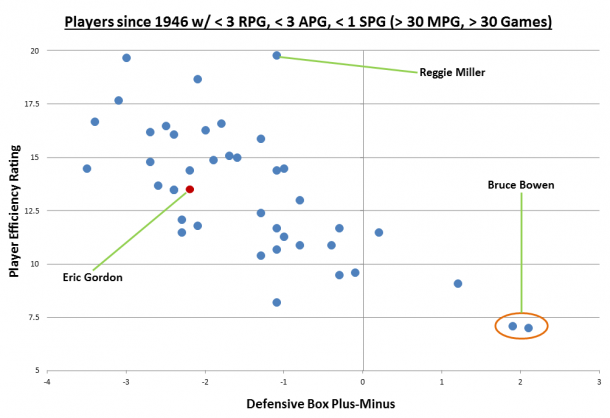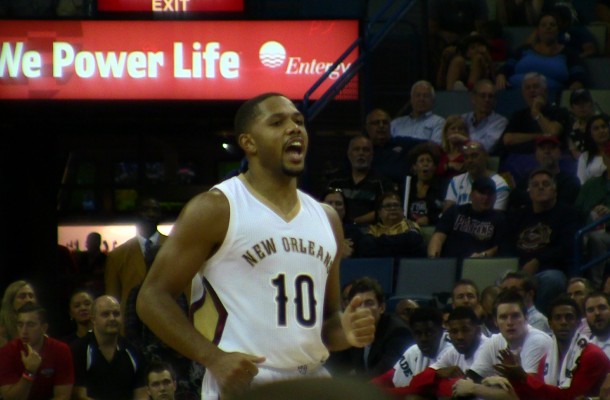Last week, Nick Lewellen wrote the following in his Season in Review piece about Ryan Anderson:
Sure, he is only 27, but the important part of NBA youth, the potential for growth, seems to be over for Ryno. That doesn’t mean we should be disappointed or expect Anderson to start regressing. No, this is simply a fact of life. Players eventually become who they are, and we have to update our short and long run expectations after this moment has passed.
That quote also seems to apply quite perfectly to 27 year old Eric Gordon, who is now eight seasons into his NBA career. For better or for worse, Gordon is who he is at this point – a legitimately dangerous floor spacer who really isn’t going to give a team much else. The 2015-16 season was his second (first in New Orleans) in which he finished with per-game averages of less than three assists, three rebounds, and one steal. He was the only NBA player to be such an “anti-box score stuffer” this season among players averaging over 30 minutes per game. Generally speaking, players who finish with similar averages while receiving heavy minutes are elite scorers, defensive stoppers, or somewhere in between. See below:
Not a pretty picture. In theory, Gordon should add value to a team’s offense as a floor spacer with or without the ball, but given his inability to have a meaningful impact on the game in other offensive areas, he usually comes out to more of a net neutral on the offensive end. He can certainly be an important piece (similar to Anthony Morrow when he was in New Orleans), but only with the right teammates on the floor. And that’s before his poor defense even enters into the conversation – though he is trending upward, Gordon hasn’t finished among the top 40 shooting guards in defensive real plus-minus in any of the past three seasons. We’ll circle back to the full picture at the end, but now that we’ve set the stage, let’s break things down a little further.
Shooting
First, the good news: Eric finished inside at a better rate than last season (51.1%), making the same number of shots in the restricted area (71) on 23 fewer attempts (139). Increased transition opportunities likely played a part in this, as those scoring chances likely come with much less defensive resistance. Regardless, it was nice to see Gordon not only improve on his typically sub-par conversion rate at the rim, but also show some athleticism that his prior knee injuries had robbed him of for so long. That apparent athleticism should be taken with a grain of salt, however; Gordon’s free throw rate (while better than last season) was still down 10% (.226) from his career average (though his higher 3-point rate certainly factors into that dip).
From a 3-point shooting perspective, it was always going to be a tall task for Gordon to match his 44.8% long range shooting numbers in 2014-15, but he almost perfectly matched his career 3-point percentage in 2015-16 of 38.4%. Digging into the numbers necessitates some further questions, though. Last season, Gordon was a catch-and-shoot machine, making 48.2% of his 253 3-point attempts taken in that manner; conversely, he only made 32.8% of his 58 pull up threes. This season, however, while his distribution of attempts was roughly the same between the two types of shots, the inverse was true in regards to his success rate. Gordon made only 34.9% of his 223 catch-and-shoot attempts from beyond the arc and 47.3% of his 53 pull up attempts. Why the change? I have a couple of theories.
Regarding the higher success on pull ups – the Pelicans relied much more on transition opportunities this season than they did last year. 37.3% of Gordon’s 3-point attempts came with between 15 and 22 seconds on the shot clock, up from just 25.4% last season (I removed shots with 22-24 seconds on the shot clock because most of these tend to be buzzer-beater attempts from around half court).
The lower success rate on catch-and-shoot attempts can likely be partially attributed to regression to the mean (the percentage of his 3-pointers that were open or wide open held at around 91-92% in each of the last two seasons), but don’t understate the importance of chemistry either – particularly between Gordon and Tyreke Evans. In 2014-15, Evans played with Gordon for 1,564 minutes (77.5% of Gordon’s total minutes) and assisted on 91 of Gordon’s 185 assisted shots (almost 50% of his makes). This season, Evans and Gordon played together for just 512 minutes (34.6% of Gordon’s total minutes), and Tyreke assisted on just 25 of his 148 assisted shots (16.8%). Part of this is a change in system, of course, but there is no denying that the two had chemistry in the old offensive system, and Eric understandably appeared to struggle some playing with so many different point guards alongside him this season.
Everything Else, Basically
I alluded to this in the intro, but Gordon was pretty much a non-factor when he wasn’t shooting the ball on offense. When you compare him with another Pelicans player who has a similar offensive reputation, that assessment holds some serious weight:

Not that different, right? Except for the fact that that Gee is a considerably better defender. There is really no polite way to put how little Eric Gordon impacted the game apart from his shooting. He can be a fine secondary ball-handler, but he often gets tied up in traffic and isn’t great at finding open teammates when he runs out of space. As a shooting guard on the shorter side (6’4″), he is rarely a factor on the glass, nor can he disrupt many shots on defense.
Summary
It is more likely than not that Eric Gordon has played his last game in New Orleans as a member of the hometown team. While the relationship began about as tumultuously as possible, things leveled out as Gordon got “healthier”, peaking with some truly elite shooting last season. Unfortunately, Gordon never came close to living up to the mini-max contract that he received four years ago, and it is pretty difficult to see him playing any sort of meaningful role on any team that has legitimate championship aspirations. With the right coach and the right training staff, maybe Gordon can improve a bit as a passer and defender, but otherwise, the Eric Gordon from the past two seasons is pretty much the Eric Gordon we’ll see moving forward, wherever his career may take him. Best of luck, Eric, and keep shooting.
(Thanks as always to Basketball-Reference.com, NBA.com/Stats, and ESPN.com for the statistical data used to support this column.)
